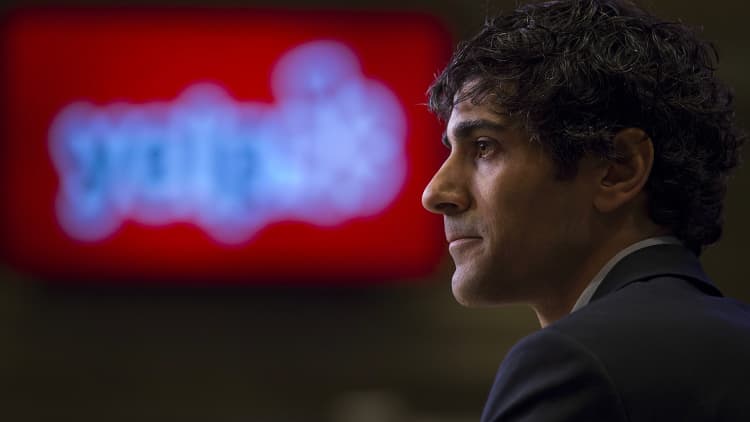Yelp might be known for helping consumers pick a nail salon or nearby restaurant. But where it sees real potential for its ads business is in multi-location businesses like Starbucks or H&R Block.
The company, which reported second-quarter earnings Thursday, saw revenue from multi-location clients during the quarter rise 21% year-over-year. Yelp has doubled down on those types of customers. In an earnings call Thursday afternoon, Yelp's departing CFO Lanny Baker called momentum in the segment of multi-location and enterprise "the most important driver" for its guidance ranges this year. The company defines these businesses as any that have more than five locations.
Yelp stock was up 5.1% Friday. The company has struggled at times in the years since it went public in 2012, in part because of increased competition from Google and Facebook. Yelp shares cratered last fall when the company said it had added zero net new advertising customers during the third quarter. The company hired Evercore earlier this year to help defend the company against an activist investor who had called for a board shake-up and potential sale. In response, the company set five-year revenue growth and EBITDA targets, brought on three new board members and authorized a $250 million share buyback.
Currently, about a quarter of the company's ad dollars come from multi-location clients, with the rest coming from local small businesses. The company's net revenue in the second quarter was $247 million, up 5% from the second quarter of 2018, driven primarily by growth in ad revenue, the company said in its shareholder letter.
The company's net revenue is overwhelmingly driven by advertising, with small portions also coming from transactions and other services. Paying advertising accounts were 197,000 in the second quarter, a 5,000 increase above the first quarter of this year. The company is also focusing on rolling out new ad products, like a "Verified License" feature (which lets businesses buy a badge that shows they have received a childcare or esthetic license, for instance) and "Business highlights" (which, for a cost, show attributes like "woman-owned and operated," "free parking" or "18 years in business.")
Though the multi-location segment isn't new for Yelp, the company's SVP of National Sales Tom Foran told CNBC in an interview in July that the segment has "found its voice" more recently.
"Our pitch is essentially that's what Yelp does best: Get users into restaurants, into retail stores, and then we measure that via our own first-party attribution ... and also through third-party partnerships," Foran said.
Ads for those business appear above a user's search result. Even though they just look like search listing, they display a little yellow box that says "Ad."
Yelp has identified 250 strategic accounts it's trying to break into, and Foran said they'd penetrated 65 to 70 of them as of last month, including McDonald's, Starbucks, Target, Olive Garden, Hilton, Under Armour, H&R Block and more. He said with the company's top 100 customers, Yelp grew the revenue in that segment by 50%.
"We really have been focusing on the big national chains and retailers. They have huge budgets and very sophisticated agency partners," he said. "The Yelp story has been underrepresented in that segment."
The company said it expects its overall sales headcount to decline "modestly" by the end of 2019 since its "decreasing reliance on growing local sales headcount to drive revenue growth more than offsets the growth of [the company's] multi-location sales teams."
The company has been rolling out "offer ads," which Foran said has real potential with major chains.
"What's interesting about a McDonald's or a Starbucks is not necessarily that you live in San Francisco and there's a McDonald's nearby, but maybe that the Shamrock Shake is available, or that the Pumpkin Spice Latte is available," he said. Those are meant to drive impulse behavior. "Ratings and reviews are key to Yelp's value proposition, but at the same time, they're less valuable for a national brand."
In its shareholder letter, Yelp said the offer ads are an example of how it's trying to meet enterprise advertisers' unique needs.
"This summer, several of the largest restaurant businesses began using limited-time Offer Ads to reach Yelp's audience of engaged consumers at their time of purchase to promote new or seasonal menu items," the letter says. "Early results from those campaigns have been strong, delivering meaningful incremental store visits at very attractive acquisition costs."
In an equity research note, Barclays analysts said the performance of its national business "encouraging." RBC Capital Markets analysts said in a research note they believe Yelp's transitions could help sustain "premium growth" at the company, but that it waits for execution around those strategies.
"Overall, we view YELP as currently undergoing several positive transitions that include its initiatives around diversifying its go-to-market strategy, capturing the multi-location opportunity, expanding product offerings with new products at lower price points, delivering greater value to business owners with new product solutions within Yelp's key categories, while also focusing on driving operational efficiencies and margin expansion," the note said.



